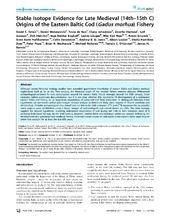| dc.contributor.author | Orton, David C. | eng |
| dc.contributor.author | Makowiecki, Daniel | eng |
| dc.contributor.author | Roo, Tessa de | eng |
| dc.contributor.author | Johnstone, Cluny | eng |
| dc.contributor.author | Harland, Jennifer | eng |
| dc.contributor.author | Jonsson, Leif | eng |
| dc.contributor.author | Heinrich, Dirk | eng |
| dc.contributor.author | Enghoff, Inge Bødker | eng |
| dc.contributor.author | Lõugas, Lembi | eng |
| dc.contributor.author | Neer, Wim Van | eng |
| dc.contributor.author | Ervynck, Anton | eng |
| dc.contributor.author | Hufthammer, Anne Karin | eng |
| dc.contributor.author | Amundsen, Colin | eng |
| dc.contributor.author | Jones, Andrew K. G. | eng |
| dc.contributor.author | Locker, Alison | eng |
| dc.contributor.author | Hamilton-Dyer, Sheila | eng |
| dc.contributor.author | Pope, Peter | eng |
| dc.contributor.author | MacKenzie, Brian R. | eng |
| dc.contributor.author | Richards, Michael | eng |
| dc.contributor.author | O’Connell, Tamsin C. | eng |
| dc.contributor.author | Barrett, James H. | eng |
| dc.date.accessioned | 2012-02-27T15:18:51Z | |
| dc.date.available | 2012-02-27T15:18:51Z | |
| dc.date.issued | 2011-11-16 | eng |
| dc.Published | PLoS ONE 6(11): e27568 | en |
| dc.identifier.issn | 1932-6203 | |
| dc.identifier.uri | https://hdl.handle.net/1956/5651 | |
| dc.description.abstract | Although recent historical ecology studies have extended quantitative knowledge of eastern Baltic cod (Gadus morhua) exploitation back as far as the 16th century, the historical origin of the modern fishery remains obscure. Widespread archaeological evidence for cod consumption around the eastern Baltic littoral emerges around the 13th century, three centuries before systematic documentation, but it is not clear whether this represents (1) development of a substantial eastern Baltic cod fishery, or (2) large-scale importation of preserved cod from elsewhere. To distinguish between these hypotheses we use stable carbon and nitrogen isotope analysis to determine likely catch regions of 74 cod vertebrae and cleithra from 19 Baltic archaeological sites dated from the 8th to the 16th centuries. d13C and d15N signatures for six possible catch regions were established using a larger sample of archaeological cod cranial bones (n = 249). The data strongly support the second hypothesis, revealing widespread importation of cod during the 13th to 14th centuries, most of it probably from Arctic Norway. By the 15th century, however, eastern Baltic cod dominate within our sample, indicating the development of a substantial late medieval fishery. Potential human impact on cod stocks in the eastern Baltic must thus be taken into account for at least the last 600 years. | en_US |
| dc.language.iso | eng | eng |
| dc.publisher | Public Library of Science | eng |
| dc.rights | Attribution CC BY | eng |
| dc.rights.uri | http://creativecommons.org/licenses/by/2.5/ | eng |
| dc.title | Stable Isotope Evidence for Late Medieval (14th–15th C) Origins of the Eastern Baltic Cod (Gadus morhua) Fishery | eng |
| dc.type | Peer reviewed | en_US |
| dc.type | Journal article | en_US |
| dc.description.version | publishedVersion | |
| dc.rights.holder | Copyright 2011 Orton et al. | |
| dc.source.articlenumber | e27568 | |
| dc.identifier.doi | https://doi.org/10.1371/journal.pone.0027568 | |
| dc.identifier.cristin | 859856 | |
| dc.source.journal | PLoS ONE | |
| dc.subject.nsi | VDP::Agriculture and fishery disciplines: 900::Fisheries science: 920 | eng |
| dc.identifier.citation | PLoS ONE. 2011, 6 (11), e27568. | |
| dc.source.volume | 6 | |
| dc.source.volume | 6 | |
| dc.source.issue | 11 | |

